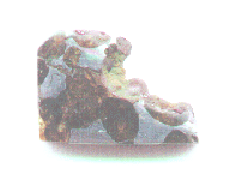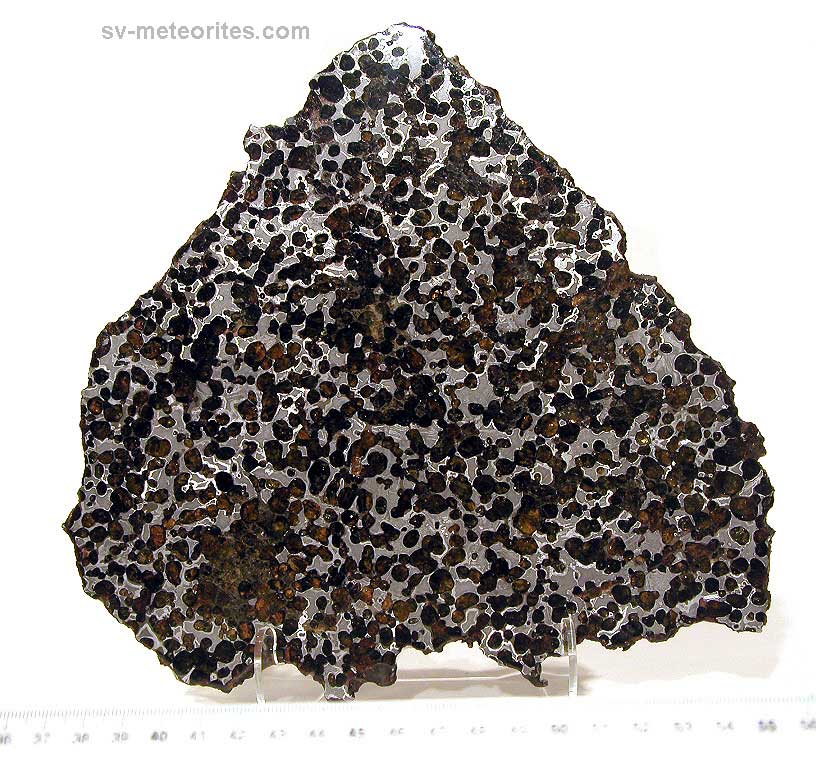PallasiteOne of two main classes of stony-iron meteorite, the other being mesosiderites. Pallasites are igneous in nature and characterized by crystals of olivine, sometimes peridot (green gem quality clear olivine crystals), embedded in a matrix of Fe-Ni metal. The type specimen, weighing 680 kg, was found in the mountains near Click on Term to Read More, MG (main-group), anomalous silicateThe most abundant group of minerals in Earth's crust, the structure of silicates are dominated by the silica tetrahedron, SiO44-, with metal ions occurring between tetrahedra). The mesodesmic bonds of the silicon tetrahedron allow extensive polymerization and silicates are classified according to the amount of linking that occurs between the composition
high-Δ17O subgroup (see details on the Imilac page)
 Recognized Summer, 1931
Recognized Summer, 1931
52° 0′ N., 108° 18′ W. Three masses weighing 85, 41, and 23 pounds, having a combined weight of 149 pounds, were found in a field 100 miles west of Saskatoon in Saskatchewan, Canada. One of the masses was sent by the finder to the Nininger MeteoriteWork in progress. A solid natural object reaching a planet’s surface from interplanetary space. Solid portion of a meteoroid that survives its fall to Earth, or some other body. Meteorites are classified as stony meteorites, iron meteorites, and stony-iron meteorites. These groups are further divided according to their mineralogy and Click on Term to Read More Laboratory in Denver where it was verified as being meteoritic. The 117 pound (52 kg) main massLargest fragment of a meteorite, typically at the time of recovery. Meteorites are commonly cut, sliced or sometimes broken thus reducing the size of the main mass and the resulting largest specimen is called the "largest known mass". Click on Term to Read More was found by Mike Farmer and team members in their 2009 expedition.
Springwater has anomalous compositions with respect to
olivineGroup of silicate minerals, (Mg,Fe)2SiO4, with the compositional endpoints of forsterite (Mg2SiO4) and fayalite (Fe2SiO4). Olivine is commonly found in all chondrites within both the matrix and chondrules, achondrites including most primitive achondrites and some evolved achondrites, in pallasites as large yellow-green crystals (brown when terrestrialized), in the silicate portion Click on Term to Read More fayalitePure* iron end-member (Fe2SiO4) of the olivine solid solution series and an important mineral in meteorites. When iron (Fe) is completely substituted by magnesium, it yields the the pure Mg-olivine end-member, forsterite (Mg2SiO4). The various Fe and Mg substitutions between these two end-members are described based on their forsteritic (Fo) Click on Term to Read More, Sc, Cr, Mn, Zn, and phosphate
REEOften abbreviated as “REE”, these 16 elements include (preceded by their atomic numbers): 21 scandium (Sc), 39 Yttrium (Y) and the 14 elements that comprise the lanthanides excluding 61 Promethium, an extremely rare and radioactive element. These elements show closely related geochemical behaviors associated with their filled 4f atomic orbital. Click on Term to Read More contents. It has a phosphoran olivine composition distinct from most other main-group pallasites (present also in Brahin, Brenham, Rawlinna 001, and Zaisho), and many of its anomalous chemical compositions suggest that it crystallized from a late-stage, P-enriched, Si-depleted melt which cooled quickly through high temperatures (Boesenberg
et al., 2004). In contrast, it has a Sc content that is the lowest among pallasites, and which is consistent with a minimally evolved melt (Mittlefehldt and Rumble III (2006). The
mineralInorganic substance that is (1) naturally occurring (but does not have a biologic or man-made origin) and formed by physical (not biological) forces with a (2) defined chemical composition of limited variation, has a (3) distinctive set of of physical properties including being a solid, and has a (4) homogeneous Click on Term to Read More farringtonite was first found in this meteorite. Springwater silicates do not follow an igneous
fractionationConcentration or separation of one mineral, element, or isotope from an initially homogeneous system. Fractionation can occur as a mass-dependent or mass-independent process. Click on Term to Read More trend, but instead are more consistent with the loss of Fe through
oxidationOxidation and reduction together are called redox (reduction and oxidation) and generally characterized by the transfer of electrons between chemical species, like molecules, atoms or ions, where one species undergoes oxidation, a loss of electrons, while another species undergoes reduction, a gain of electrons. This transfer of electrons between reactants Click on Term to Read More as a magmatic gas phase was introduced (Wasson and Choi, 2003). These
oxidizingOxidation and reduction together are called redox (reduction and oxidation) and generally characterized by the transfer of electrons between chemical species, like molecules, atoms or ions, where one species undergoes oxidation, a loss of electrons, while another species undergoes reduction, a gain of electrons. This transfer of electrons between reactants Click on Term to Read More gases were concentrated in voids formed by
coreIn the context of planetary formation, the core is the central region of a large differentiated asteroid, planet or moon and made up of denser materials than the surrounding mantle and crust. For example, the cores of the Earth, the terrestrial planets and differentiated asteroids are rich in metallic iron-nickel. Click on Term to Read More contraction and
mantleMain silicate-rich zone within a planet between the crust and metallic core. The mantle accounts for 82% of Earth's volume and is composed of silicate minerals rich in Mg. The temperature of the mantle can be as high as 3,700 °C. Heat generated in the core causes convection currents in Click on Term to Read More collapse during cooling, and they introduced enrichments of the
volatileSubstances which have a tendency to enter the gas phase relatively easily (by evaporation, addition of heat, etc.). siderophiles Ge and Ga into various pallasitic lithologies.
Springwater and the other PMG-as members might have formed in a more chemically heterogeneous mantle region than normal PMG members, though overall compositional and isotopic similarities still suggest a common
parent bodyThe body from which a meteorite or meteoroid was derived prior to its ejection. Some parent bodies were destroyed early in the formation of our Solar System, while others like the asteroid 4-Vesta and Mars are still observable today. Click on Term to Read More for all. It has been proposed that main-group pallasites could represent melt residues of the IIIAB iron parent body. However, due to the significantly slower cooling experienced by main-group pallasites compared to IIIAB irons, as well as the younger ages determined for main-group pallasites, a common parent body is not considered plausible by some (E. Scott, 2007). Moreover, pallasites have a much younger range of CRE ages than the IIIAB irons (Huber
et al., 2011), although this may be explained by the higher space endurance of the irons.
Formation scenarios and classification schemes for the main-group pallasites can be found on the
Imilac page. Shown above is a 3.5 g specimen of Springwater purchased from M. Killgore in 1995. The excellent photo below is a large etched slice of Springwater exhibiting the typical distribution of silicate and
metalElement that readily forms cations and has metallic bonds; sometimes said to be similar to a cation in a cloud of electrons. The metals are one of the three groups of elements as distinguished by their ionization and bonding properties, along with the metalloids and nonmetals. A diagonal line drawn Click on Term to Read More, shown courtesy of Sergey Vasiliev.

Photo courtesy of Sergey Vasiliev—
SV-meteorites.com








